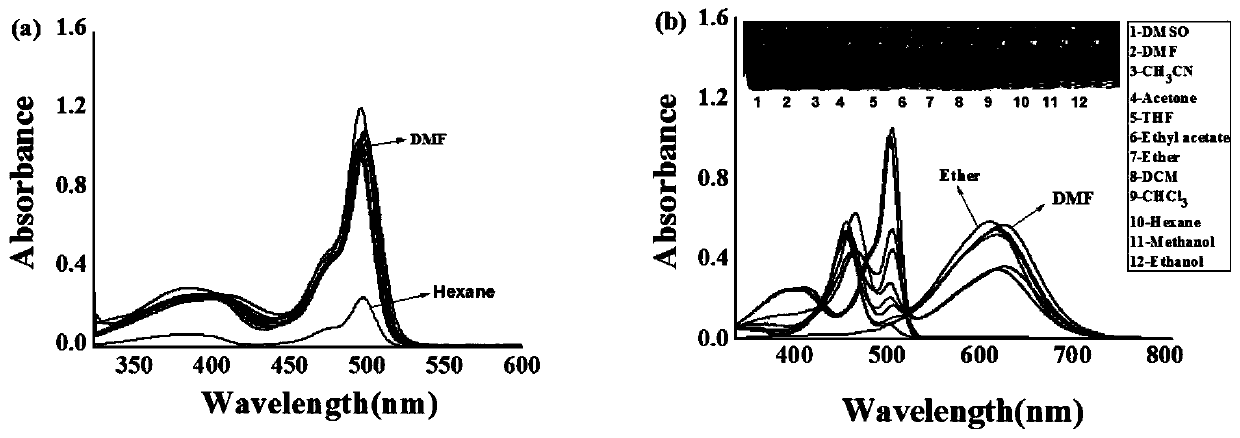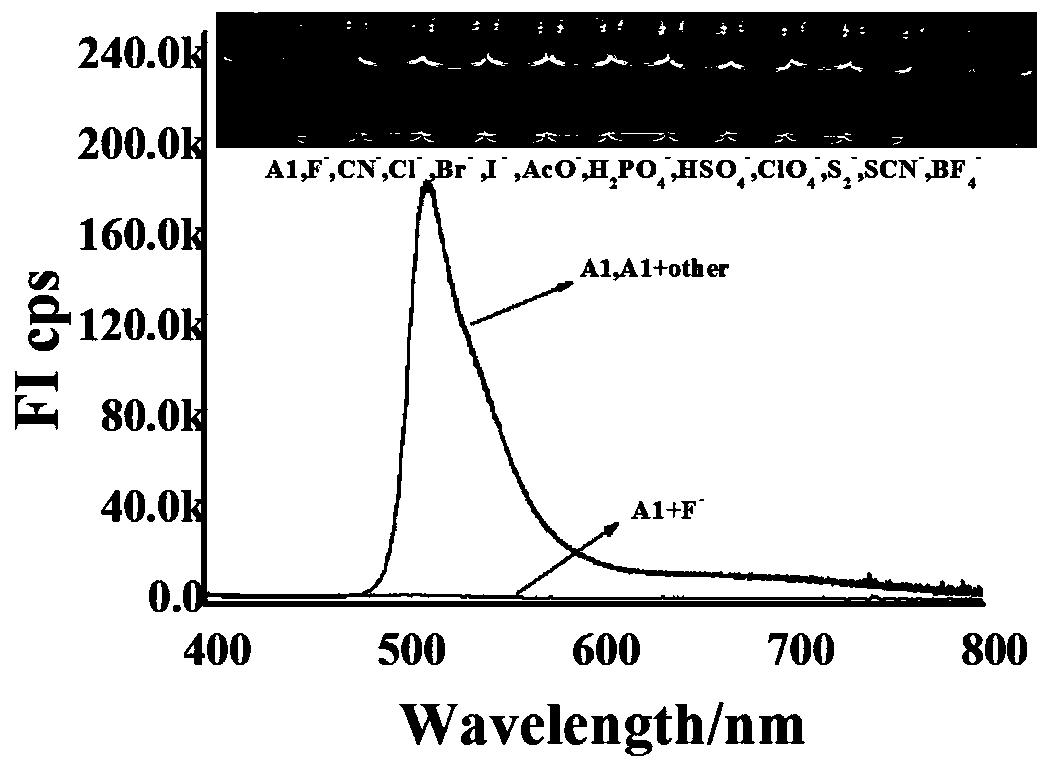Fluorescent probe for detecting fluorine ions and preparation method and application thereof
A fluorescent probe and fluoride ion technology, applied in the field of fluorescent probes, can solve the problems of complicated probe operation, high cost, difficult to identify anions, etc., and achieve the effect of good ultraviolet absorption performance
- Summary
- Abstract
- Description
- Claims
- Application Information
AI Technical Summary
Problems solved by technology
Method used
Image
Examples
Embodiment 1
[0059] The synthesis of fluorescent probe molecules for detecting fluoride ions in the present invention is obtained through a series of reactions using p-hydroxybenzaldehyde, pyrrole and tert-butyldiphenylchlorosilane as raw materials, including the following steps
[0060] (1) Synthesis of 4-(bis(1H-pyrrol-2 base)methyl)phenol:
[0061] p-Hydroxybenzaldehyde (5.00g, 40.94mmol), pyrrole (20mL, 289mmol) and anhydrous CH 2 Cl 2 (250 mL) was added into a 500 mL round-bottomed flask, nitrogen was replaced in the round-bottomed flask, and trifluoroacetic acid (200 mg, 2.60 mmol) was added to the mixture, and the reaction was stirred at room temperature for 3 h. After the reaction was complete, it was washed with saturated sodium bicarbonate solution. The organic layer was dried over anhydrous sodium sulfate, the filtrate was collected, concentrated by distillation under reduced pressure, and purified by silica gel column chromatography (petroleum ether: ethyl acetate = 3:1) to o...
Embodiment 2
[0110] A method for preparing a fluorescent probe for detecting fluoride ions, the method comprising the following steps:
[0111] (1) Synthesis of 4-(bis(1H-pyrrol-2 base)methyl)phenol:
[0112] In a dry nitrogen atmosphere, first stir and dissolve p-hydroxybenzaldehyde and pyrrole in the solvent anhydrous dichloromethane, and replace with nitrogen to form a mixture, then add trifluoroacetic acid to the mixture and react at room temperature for 2 hours; wait until the reaction is complete Afterwards, wash and dry, distill under reduced pressure, and collect after silica gel column chromatography to obtain brown solid 4-(bis(1H-pyrrol-2 base)methyl)phenol; wherein, p-hydroxybenzaldehyde, pyrrole, trifluoroacetic acid and no The molar volume ratio of dichloromethane in water is 40mmol: 280mmol: 2mmol: 250ml, and the developing solvent and volume ratio used for silica gel column chromatography purification are respectively petroleum ether: ethyl acetate=3:1;
[0113] (2) Synthe...
Embodiment 3
[0126] A method for preparing a fluorescent probe for detecting fluoride ions, the method comprising the following steps:
[0127] (1) Synthesis of 4-(bis(1H-pyrrol-2 base)methyl)phenol:
[0128]In a dry nitrogen atmosphere, first stir and dissolve p-hydroxybenzaldehyde and pyrrole in the solvent anhydrous dichloromethane, and replace with nitrogen to form a mixture, then add trifluoroacetic acid to the mixture and react at room temperature for 4 hours; wait until the reaction is complete Afterwards, wash and dry, distill under reduced pressure, and collect after silica gel column chromatography to obtain brown solid 4-(bis(1H-pyrrol-2 base)methyl)phenol; wherein, p-hydroxybenzaldehyde, pyrrole, trifluoroacetic acid and no The molar volume ratio of dichloromethane in water is 45mmol: 300mmol: 3mmol: 250ml, and the developing solvent and volume ratio used for silica gel column chromatography purification are respectively petroleum ether: ethyl acetate=3:1;
[0129] (2) Synthes...
PUM
 Login to View More
Login to View More Abstract
Description
Claims
Application Information
 Login to View More
Login to View More - R&D
- Intellectual Property
- Life Sciences
- Materials
- Tech Scout
- Unparalleled Data Quality
- Higher Quality Content
- 60% Fewer Hallucinations
Browse by: Latest US Patents, China's latest patents, Technical Efficacy Thesaurus, Application Domain, Technology Topic, Popular Technical Reports.
© 2025 PatSnap. All rights reserved.Legal|Privacy policy|Modern Slavery Act Transparency Statement|Sitemap|About US| Contact US: help@patsnap.com



